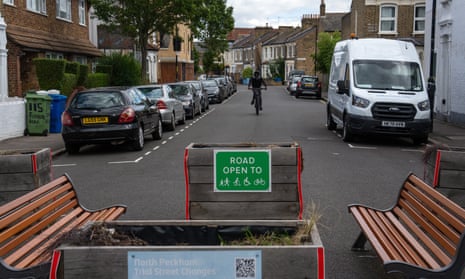Policies to help people walk and cycle such as low-traffic neighbourhoods can create public health benefits as much as 100 times greater than the cost of the schemes, a long-term study of active travel measures has concluded.
The research, based on six years of surveys among thousands of people living in three outer London boroughs that introduced LTNs or similar schemes, found they tended to prompt people to switch some trips from cars to active travel, although the effects were varied.
The cumulative public health benefit of people being more active was estimated at as much as £4,800 per local adult over a 20-year period, the authors found, as against a cost per person to build LTNs of about £28-£35, or £112, depending on the type of scheme built.
Significantly, the study found that the positive impacts, particularly for walking and cycling rates, tended to be more noticeable after schemes had been in place for a year or two, rather than immediately, indicating that councils should not determine an LTN’s success or otherwise too early.
It comes on the day that Lambeth council in south London scrapped one LTN scheme after complaints it led to significantly slower bus journey times on a main road.
The research, led by Prof Rachel Aldred of Westminster University, also suggested that the positive benefits tend to continue growing over time, meaning the benefit-to-cost ratio for LTNs of between 50-1 and 200-1 estimated by the study are likely to be conservative.
LTNs are another name for what is known as modal filtering, a traffic management tool that uses signs or physical barriers like planters that prevent motor vehicles from using smaller, residential streets as cut-throughs but allow full access for pedestrians and bikes.
While this has been widely used for decades, including in the UK, the rebrand as LTNs and a massive expansion of sometimes initially misfiring schemes during Covid – new LTNs in 2020 covered 4% of London’s population – made them controversial.
While studies appear to show their effectiveness, and polling and elections tend to indicate they are popular, the Department for Transport announced last year it would no longer fund councils to introduce them after media controversy.
The new study suggests blocking new LTNs would be counterproductive, both in terms of traffic planning and public health.
It was based on surveys of the same group of people in three outer London boroughs, Enfield, Kingston and Waltham Forest, plus a control group in other outer boroughs, over a six-year period, with between 1,354 and 1,712 people taking part in each wave of questions. They all built LTN-type schemes before Covid as part of the “mini-Holland” programme dating from when Boris Johnson was London mayor.
The respondents were split into various groups: a “low dose” one, who lived in one of the three boroughs but not inside a mini-Holland scheme; “high dose”, who lived inside such a scheme; and a control group, living in other outer London boroughs.
after newsletter promotion
The most notable changes over time were found among people inside the LTNs, with what the authors called “substantial” average increases in reported walking and cycling levels, and a smaller such effect for people living not in LTNs but near other active travel schemes like bike lanes.
Both these areas also saw signs of decreased car ownership, although this was marginal in the non-LTN group
Using a Department for Transport tool that calculates the economic benefits from people being more active, both in terms of better health and reduced workplace sickness, the study calculated a total 20-year dividend from the LTN areas in the three boroughs at slightly over £1bn, with £821m coming from public health. It found that each year an average of 37 deaths and more than 500,000 sick days were avoided.
“Active travel interventions provided high value for money when comparing health economic benefits from physical activity to costs of scheme implementation, particularly low traffic neighbourhoods,” the study concluded.
